Table of contents
Celery ( Apium graveolens var. dulce), also known as celery sticks and celery (lighter in colour) is a cultivated form of wild celery. The crunchy leaf stalks ( organic?) are particularly popular as raw food ( raw), but also taste good cooked.
Use in the kitchen
What is celery? In contrast to celeriac, celery (stalks) only form small bulbs, but have fleshy leaf stalks with leaves at the ends. Depending on the variety, fresh celery is either strong green or pale white to yellowish-light green in color; the lighter specimens are called blanched celery (in everyday life, however, this distinction is not taken so seriously, so both terms can appear as synonyms). Celery has a spicy, aromatic taste with a slight spiciness.
What is blanched celery? These types of celery are left to grow in a light-tight manner for a while before harvesting - or self-bleaching varieties are used. Both variants produce less chlorophyll (leaf green). 7,13,14 The aroma of blanched celery is considered to be more delicate and somewhat sweeter.
Processing celery sticks: For tender sticks, a light wash is sufficient. Only thick stalks taste better when peeled. When bent, the stalks usually break immediately. Celery sticks that can be bent are over-aged.
Can you eat celery raw? Yes, you can eat celery raw. The tender inner stalks are particularly good for salads - or they can be used as healthy, crunchy sticks for a vegan dip. Celery tastes great with fruit. The combination with apples and grapes is very popular.
In addition to being eaten raw, celery can also be steamed or fried. The vegetable makes a good side dish for all kinds of vegetarian and vegan dishes, such as pasta, rice and wok dishes. It is also ideal as a component of vegetable soups, lasagne (vegan) and sauces. Stews with a slight sweetness (e.g. with lentils, carrots and tomatoes) can take on a fine and slightly spicy aroma thanks to celery. Celery also tastes delicious in potato gratins or baked with vegan cheese.
Celery sticks can be used with apples and ginger to make healthy green smoothies. The Bloody Mary cocktail, with or without alcohol, is traditionally served with a stick of celery.
You can also use the leaves of the celery stalks. You can either pluck them off and use them fresh like parsley, or you can dry them, grind them and mix them with salt. Celery salt is suitable for seasoning salads, sauces, tomato juice and vegetables - it tastes wonderful with grilled corn on the cob and mushrooms.
Celery seeds (actually celery fruits) are used as a spice or for medicinal purposes. 13
Vegan recipe for celery and chickpea salad
Ingredients (for 6 people): 150 g celery (raw, organic), 200 g chickpeas (cooked), 6 tbsp rapeseed oil (or less), 3 tbsp white wine vinegar, 2 tbsp lemon juice, ½ tsp coriander (dried), ¼ tsp salt, ½ tsppepper, 6 tbsp raisins.
Preparation: Wash the raw celery and cut into bite-sized pieces. Rinse the chickpeas and drain. For the dressing, mix the rapeseed oil, white wine vinegar, lemon juice, coriander, salt and pepper well. The salad dressing also works with less rapeseed oil (you can find more on this topic in the link below). Add the celery, chickpeas and raisins and mix. Serve the vegan celery salad raw with flatbread, for example.
Vegan recipes with celery can be found under the note: " Recipes that have the most of this ingredient ".
| Not only vegans or vegetarians should read this: Vegans often eat unhealthily. Avoidable nutritional mistakes |
Purchasing - Storage
Supermarkets such as Coop, Migros, Denner, Volg, Spar, Aldi, Lidl, Rewe, Edeka, Hofer etc. offer celery almost all year round. Celery is in season in Central Europe from May to December. In the remaining months, celery is mostly imported. Organic supermarkets (e.g. Denn's Biomarkt, Alnatura) also offer celery seasonally, of course in organic quality (organic celery). Very fresh and local celery is available at the weekly market.
The variety 'Tall Utah' is mostly described as not self-bleaching - in contrast to 'Spartacus', 'Tango', 'Pascal', 'Golden' ('Golden Self-Blanching') and others (self-bleaching). However, the information available is often contradictory, also because there are different sub-varieties or varieties. Seed suppliers usually provide this information on the packaging.
The availability of celery varies depending on the size of the store, catchment area, etc. Our recorded food prices for the DA-CH countries can be found above under the ingredient image - and by clicking on them you can see their development at various suppliers.
Wild
celery is found all over the world. It grows on moist, saline soils on coasts, as well as in marshes, swamps, wet meadows and ditches. 1,2 Read more about the danger of confusion below. The wild ancestors of celery lost their very bitter and overly intense aroma through breeding and selection. 13
Storage tips
Celery will keep for one to two weeks in the vegetable compartment of the refrigerator. Wrapped in a damp cloth, cut celery stalks are very well protected from drying out prematurely. Perishability increases if stored next to fruit that is ripening.
Freezing celery (freezing celery sticks): Once washed and cut into fine pieces, celery can also be frozen raw. To preserve the color, flavor and cell structure better and for longer, blanch the cut sticks briefly before freezing (boil in water for 1-2 minutes, then rinse in ice cold water).
Ingredients - Nutritional values - Calories
Celery is very low in calories and fat, with 16 kcal/100g and 0.17 g fat per 100 g. It also contains small amounts of fiber (1.6 g/100g) and protein (0.69 g/100g). 3
Celery is rich in vitamin K (29 µg/100g; 39% of the daily requirement). Rhubarb (29 µg/100g) and kefe (25 µg/100g) contain a similar amount. Swiss chard contains a particularly high amount of vitamin K, at 830 µg/100g . 3
36 µg of folate are found in 100 g of raw celery (18% of the daily requirement). Chicory (37 µg/100g) has a similar content. Raw edamame contains almost ten times as much folate at 303 µg/100g. 3
The content of vitamin B6 (pyridoxine) in celery is 0.07 mg/100g (5% of the daily requirement). This is similar to that of rocket (0.07 mg/100g) and romaine lettuce (0.07 mg/100g). Significantly more vitamin B6 can be found in raw pistachios (1.7 mg/100g). 3
Bleached celery generally contains less chlorophyll and has lower nutrient levels than the strong green variety; according to the source cited, this mainly affects the vitamin A content. 13 This is because when bleaching celery, the stalks are covered with soil or other substrates to inhibit chlorophyll production. The reduced light exposure also gives the stalks a lighter color and a milder flavor.
You can find all the celery ingredients, the coverage of the daily requirement and comparison values with other ingredients in our nutrient tables. In the article Nutrients explained you will get a detailed insight into the topic.
Health Effects
Is celery healthy? Celery has very few calories and consists mostly of water, which is why it is excellent for weight loss and can help treat obesity. Apium graveolens contains important phytochemicals such as phenolic acids, flavones, flavonols and other antioxidants that can reduce oxidative damage and prevent inflammation. These ingredients have a cholesterol-lowering and blood pressure-lowering effect and reduce blood sugar levels, which is why celery is recommended for diabetics. 4,5
Celery is said to prevent cardiovascular diseases, jaundice, liver disease, gout and rheumatic diseases. Studies have also shown that celery has antifungal and antibacterial properties. The seeds are applicable in the treatment of bronchitis, asthenopia, asthma, vomiting and fever. 6 The phthalides, bioactive compounds contained in celery, are said to protect against cancer and reduce tumors. 7
The bioactive substances in celery help with all kinds of complaints. The essential oil has a diuretic effect and provides relief from edema, kidney stones and gout, for example. Alkaline mineral salts neutralize excess acids in the body. Celery also contains psoralens. These are active ingredients that can cause increased sensitivity to light in some people. 5 In people with skin diseases (eg psoriasis vulgaris), these active ingredients are used in combination with UVA radiation as a form of therapy to counteract intensely itchy inflammation. 12
Dangers - Intolerances - Side effects
Is celery harmful to health? Celery is one of the 14 main allergens and must be labelled in the EU. 8 Celery allergy usually occurs in combination with a pollen allergy (e.g. celery-carrot-mugwort-spice syndrome). Allergic reactions to celery range from mild, local reactions in the oral cavity to severe, systemic reactions (e.g. anaphylactic shock). Some celery allergens have proven to be largely heat and processing resistant; therefore, people who are sensitive to celery should avoid all products containing celery. 9
Can you eat celery when pregnant? Celery contains apiol, an essential oil. In highly concentrated amounts, it is said to cause irritation to the uterus and trigger contractions (labor). It is also said to be problematic for the kidneys and liver. For this reason, pregnant women and people suffering from kidney inflammation are often advised against eating or using celery. 2 Opinions on this vary greatly and there is hardly any scientific research on the subject. It can be assumed that the amount is crucial for such effects.
The phototoxic furocoumarins mentioned above, the psoralens, can trigger acute skin reactions (burning erythema) when exposed to sunlight and subsequently lead to inflammation with itching and redness. It was long believed that only celery infected with the fungal parasite "pink-red" could trigger these reactions, as the infection induced an increased production of furocoumarins. However, it is now known that celery that has been bred to be resistant to this fungal infection also has an increased content of furocoumarins. 10
confused
Due to its appearance and smell, celery can be with water hemlock (poisonous water hemlock, Cicuta virosa). and the yellow vine umbel (saffron umbel, poisonous vine umbel, Oenanthe crocata); both are also members of the Umbelliferae family. Since these plants are poisonous, caution is advised. 8
Folk medicine - natural medicine
In folk medicine, celery salad (or freshly squeezed celery juice) is very popular as a diuretic. Celery tea, which is made from celery herb, is recommended for nervous weakness, chronic lung diseases, rheumatism and gout. 2 In the Middle Ages, celery was famous as an aphrodisiac. Even today, some people believe that celery has a potency-enhancing effect, although this has not been proven. 1,8
In Traditional Chinese Medicine ( TCM), celery is used as a remedy for high blood pressure. 11
Ecological footprint - animal welfare
Celery in conventional cultivation requires a high use of pesticides and other chemical agents, which are not used in organic celery. We therefore recommend paying attention to organic products when shopping.
According to a Danish study, the carbon footprint of celery is 0.33 kg CO 2 eq/kg. Agriculture (along with land use changes, processing, transport, packaging and trade) was the most serious factor, with 0.15 kg CO 2 eq/kg. 18 A life cycle analysis by researchers in Germany came up with a value of 0.2 kg CO 2 eq/kg. To put these values into context, here are a few other products that are available in Germany: pineapple imported by ship has a footprint of 0.6 kg CO 2 eq/kg, by plane it comes to 15.1 kg CO 2 eq/kg. An organic apple has about 0.2 kg CO 2 eq/kg; an apple imported from New Zealand can have up to 0.8 kg CO 2 eq/kg. Average beef comes to 13.6 kg CO 2 eq/kg. 19
The global average water footprint of vegetables is 322 l/kg (blue, green and grey water). For comparison: fruit comes to 460 l/kg, 20 eggs come to 3265 l/kg (most green water with 2592 l/kg) and beef comes to 15,415 l/kg. 21 Vegetables grown in dry areas can also require a lot of water. For celery, it is also important to be able to provide the plant with a good water supply – that is, to cultivate it under humid weather conditions. 16 To understand the full impact of consumption on the water footprint, the water footprint should be put into context with local conditions.
For detailed explanations of various sustainability indicators (such as ecological footprint, CO2 footprint, water footprint), see our article: What does the ecological footprint mean?
Worldwide occurrence - cultivation
Celery comes from the eastern Mediterranean. Cultivated forms of celery appeared in the Middle Ages. Through breeding and targeted selection, especially in Italy, the mildly aromatic celery with crisp, juicy leaf stalks was created. 1 Celery is now grown worldwide in places with a temperate climate, e.g. in Europe, North America, North Africa and Siberia. 11 Celery can be found particularly on moist, nutrient-rich, saline soils, especially near the sea. 17
Cultivation - Harvest
The seeds are grown indoors (on the windowsill or in the greenhouse) in early March. In May, the plants are planted outside in a bed with nutrient-rich soil. Young celery needs regular water. 11
Celery plants grow particularly well in fertilized, sandy loam soils under mild climatic conditions and reach a height of about 40 cm.
In the case of blanched celery, a whitish to golden yellow or light green variety, the leaf stalks are covered with straw, paper, cardboard or foil before harvesting (blanching); or the plant is grown without direct sunlight on a mound of earth (piled up earth) or in a deep trench (trenching). This inhibits the production of chlorophyll (the green pigment) and the stalks or the plant remain pale. 7,15 Newer varieties are self-bleaching, which saves the above-mentioned work.
Further information
Celery ( Apium graveolens var. dulce) belongs to the family of Apiaceae. In addition to celery, there are two other cultivated varieties: celeriac ( Apium graveolens var. rapaceum) and cut celery ( Apium graveolens var. secalinum). You can read more about the taxonomy under celeriac.
Similar to horses and donkeys, celery and parsley can also produce fertile offspring. This cross is commercially available as a 'parcel'. 16
Alternative names
Celery is also called stalk celery, stick celery and bleached celery. Incorrect spellings such as Staudenselerie, Staudenselleri, Stauden Celery, Stauden Selleri, Staudenseller, Staufensellerie, Stautensellerie, Bleichselerie, Bleichselleri and Bleich Celery creep in. Eppich, Zeller, Zellerer, Gailwurz, Schoppenkraut and Suppenkraut are colloquial names for celery.
According to Duden, celery (like celery) can be male or female. We have chosen the male variant here.
In English, it is called celery, stalk celery or petiolate celery. Blanched celery or self blanching (self-blanching) celery.
Other uses
Celery fruits are grown on a large scale in India, southern France, China and Egypt. Celery seeds contain 2% essential oil, which is used to flavor foods and in the perfume industry. Celery essential oil gives perfumes a floral scent with a warm and cuddly note. 7
Bibliography - 21 Sources (Link to the evidence)
| 1. | Biothemen.de Sellerie - Stange, Knolle, Blatt - eine kleine Warenkunde. |
| 2. | Pahlow M. Das grosse Buch der Heilpflanzen. Gesund durch die Heilkräfte der Natur. Nikol Verlagsges. mbH: Hamburg; 2013; 290-291. |
| 3. | USDA United States Department of Agriculture. |
| 4. | Hedayati N, Bemani Naeini M, Mohammadinejad A, Mohajeri SA. Beneficial effects of celery (Apium graveolens) on metabolic syndrome: A review of the existing evidences. Phytother Res. 2019;33(12):3040–53. |
| 5. | Roger JDP. Heilkräfte der Nahrung. Advent-Verlag: Zürich. 2006: 232-233. |
| 6. | Kooti W, Daraei N. A review of the antioxidant activity of celery (Apium graveolens L). J Evid Based Complementary Altern Med. 2017;22(4):1029–34. |
| 7. | Sowbhagya HB. Chemistry, technology, and nutraceutical functions of celery (Apium graveolens L.): an overview. Crit Rev Food Sci Nutr. 2014;54(3):389–98. |
| 8. | Pini U. Das Bio-Food Handbuch. Ullmann Verlag: Potsdam; 2014: 679-680. |
| 9. | Farrp.unl.edu Allergenic Foods and their Allergens, with links to Informall - Vegetables. |
| 10. | Deleo VA. Photocontact dermatitis. Dermatologic Therapy. 2004;17(4):279–88. |
| 11. | Eurapon.de Sellerie: Viel mehr als ein Suppengemüse. |
| 12. | Aryee-Boi J. Dusch-PUVA : Ein innovatives Verfahren der lokalen PUVA-Therapie. Klinische und pharmakokinetische Ergebnisse bei Psoriasis vulgaris. 2002. |
| 13. | Malhotra S. Celery. In: Peter K.V. (Ed.). Handbook of Herbs and Spices, 2th Edition, Woodhead Publishing Ltd. 2012: 249–267. |
| 14. | Plantura.garden Staudensellerie: Pflanzen, Ernten & Zubereiten des gesunden Gemüses. |
| 15. | History.denverlibrary.org Trembath BK. Trenched celery, blanched celery and Pascal celery: The forgotten story of Colorado's once mighty celery industry. 2021. |
| 16. | Heistinger A, NOAH VA. Handbuch Bio-Gemüse: Sortenvielfalt für den eigenen Garten. Löwenzahn Verlag; 2020. 1013 S. |
| 17. | Bäumler S. Heilpflanzenpraxis heute - Arzneipflanzenporträts: Heilpflanzenpraxis heute - Arzneipflanzenporträts. Elsevier Health Sciences; 2021. 875 S. |
| 18. | CONCITO.The big climate database. Climate footprint. Version 1.1. Celery. 2024. |
| 19. | Reinhardt G, Gärtner S, Wagner T. Ökologische Fussabdrücke von Lebensmitteln und Gerichten in Deutschland. Institut für Energie - und Umweltforschung Heidelberg. 2020. |
| 20. | Mekonnen MM, Hoekstra AY. The green, blue and grey water footprint of crops and derived crop products. Hydrol Earth Syst Sci. 25. Mai 2011;15(5):1577–1600. |
| 21. | Mekonnen MM, Hoekstra AY. A global assessment of the water footprint of farm animal products. Ecosystems. April 2012;15(3):401–415. |

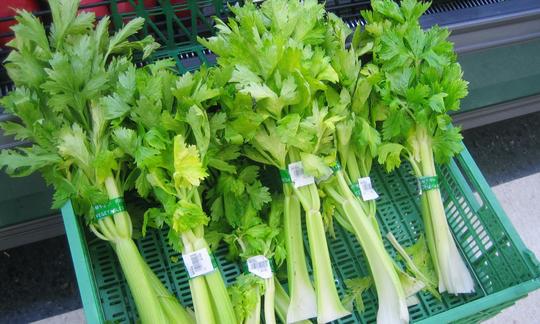

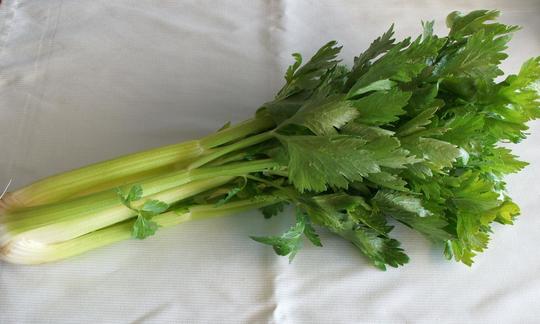

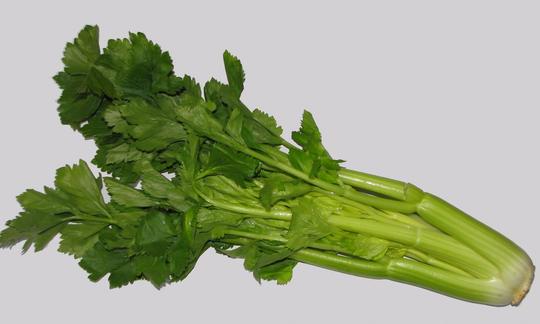


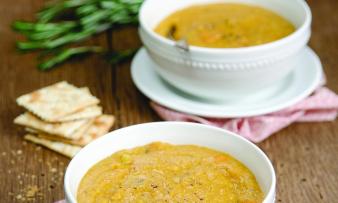
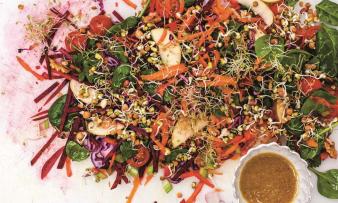





Comments